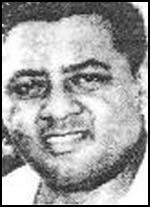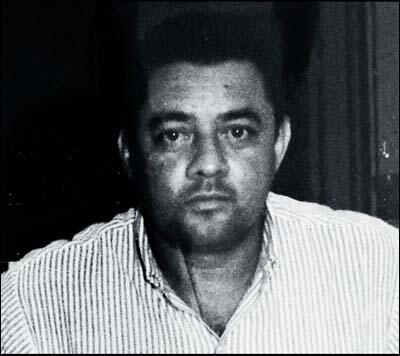Herminio Diaz Garcia

Herminio Diaz Garcia was born in Cuba in 1923. He was a member of the Cuban Restaurant Workers Union and worked as a cashier at the Hotel Habana-Rivera. Later he became involved in illegal activities and eventually became a bodyguard for Santos Trafficante.
Diaz Garcia killed Pipi Hernandez in 1948 at the Cuban Consulate in Mexico. In 1957 he was involved with an assassination attempt against President Jose Figures of Costa Rica.
Diaz Garcia moved to the United States in July, 1963, where he worked for Tony Varona. Some researchers believe that Dia Garcia was one of the gunman who killed John F. Kennedy on 22nd November, 1963.
In December, 1963, Dia Garcia was involved in an unsuccessful attempt to assassinate Fidel Castro. He was also involved in providing weapons to anti-Castro groups.
Diaz Garcia was killed on a mission at Monte Barreto in the Miramar district of Cuba on 29th May, 1966. Tony Cuesta was captured during the mission. Cuesta, who always vowed that Castro would never take him alive, attempted suicide by setting off a grenade, which blinded him and blew off his right hand. Cuesta spent a long time in hospital as a result of his serious injuries. Herminio Diaz Garcia is buried in Columbus, Havana.

In 1978 President Jimmy Carter arranged for a group of imprisoned exiles in Cuba to be released. This included Tony Cuesta who was involved in an attack on Cuba in 1966. Just before leaving Cuba Cuesta asked to see Fabian Escalante. Cuesta told Escalante that he had been involved in the assassination of President John F. Kennedy. He also named Diaz Garcia and Eladio del Valle as being involved in the conspiracy. Cuesta asked Escalante not to make this information "made public because I am returning to my family in Miami - and this could be very dangerous."
Tony Cuesta returned to Miami and died in 1994. The following year, Wayne Smith, chief of the Centre for International Policy in Washington, arranged a meeting on the assassination of John F. Kennedy, in Nassau, Bahamas. Others in attendance were: Gaeton Fonzi, Dick Russell, Noel Twyman, Anthony Summers, Peter Dale Scott, Jeremy Gunn, John Judge, Andy Kolis, Peter Kornbluh, Mary and Ray LaFontaine, Jim Lesar, John Newman, Alan Rogers, Russ Swickard, Ed Sherry, and Gordon Winslow.
Some high-level Cuban officials attended the conference. This included Fabian Escalante, Carlos Lechuga, former Cuban diplomat, and Arturo Rodriguez, a State Security official. Escalante revealed details of Cuesta's confession. He also informed the group they had a spy in the anti-Castro community in Miami and knew about the plot to kill Kennedy.
Primary Sources
(1) Mary Louise Wilkinson, Miami News (31st May, 1966)
Two Miami exiles who were killed after landing near a heavily populated Havana suburb were on a mission to assassinate Fidel Castro, the Cuban government claimed today.
The incident occurred late Sunday near the Comodoro Yacht Club in suburban Miramar, when Commandos L, a Miami-based action group, put Sandalio Herminio Diaz and Armando Romero ashore from a 23-foot boat, the Cuban communiqué said.
Tony Cuesta, 39 - year - old group leader, and Eugenio Zaldivar Xiques were captured after being seriously wounded in a gunfight 10 miles off the coast. Two other crewmen, listed only as "Guillermo" and "Roberto" (alias Cara Vieja), were missing - and presumed drowned.
In Miami, where Cuesta has lived since 1960, his wife said she had no further information about the fate of her husband.
"I hope and pray he is all right," said Mrs. Cuesta. "But regardless of what happens, we must continue the fight against Castro. I knew before he set out that the operation was risky."
According to the Cuban Interior Ministry communiqué Commandos L launched the infiltration attempt from Marathon. The Castro officials made their usual claim that the group was sponsored by the American government.
"The objective, according to the prisoners' confession, was to assassinate the prime minister in order to create conditions favorable for an imperialist aggression," the communiqué claimed.
Government-controlled newspapers in Havana carried pictures of material allegedly seized from the boat, including hand grenades, plastic explosives, submachine guns and anti-Castro leaflets.
The infiltration try came immediately after Castro announced an island-wide combat alert against "imperialist aggressors" following a series of incidents at the U. S. Naval Base at Guantanamo in which an armed Cuban soldier was shot and killed.
Last year, Commandos L teamed up with the Cuban Referendum in Exile (RECE), sponsored by rum millionaire Jose M. Bosch, to carry out a series of attacks against Cuba.
However, Ernesto Freyre, of RECE, denied knowledge of the Sunday raid, stating, "I am sorry but there is nothing I can say."
In November, the two groups joined with the 30th of November Movement here to strafe a police station on the Havana waterfront. Three years ago, Cuesta led a Commandos L raid against the Russian freighter Baku in a Cuban port which prompted a Soviet protest note to Washington.
Sunday's infiltration attempt came on the heels of a claim by the Second Front of the Escambray-Alpha 66 that they raided a naval past at Tarara Beach, same 20 miles east of Havana, on May 19 and slipped back to a "secret Caribbean base" without losing men or equipment.
Despite the latest failure, exile activists here appeared to intensify plans for future anti-Castro action.
Manuel Antonio de Varona, former Cuban prime minister and head of the Rescate movement, flew here from his exile home in New York to coordinate plans for an action group merger that reportedly included the Second Front.
Varona, who served briefly as head of the now-defunct Cuban Revolutionary Council, said, "We must not give Castro a breather. There should be well-coordinated actions from outside to encourage the people inside to work toward overthrow of the dictator."
(2) James Richards, JFK Assassination Forum (25th June, 2004)
I'm sure there was Mafia involvement which came via John Roselli. One of the shooters (Herminio Diaz Garcia) may have come via this connection. Diaz Garcia was Trafficante's bodyguard during the Havana casino days and was most likely the man Roselli reached out to in those early days of the Castro assassination plots.
(3) Fabian Escalante, Cuban Officials and JFK Historians Conference (7th December, 1995)
During 1960, Santos Trafficante also had a Cuban bodyguard. His name was Herminio Diaz Garcia... Hernandez met and talked with Richard Cain in December of 1960 regarding a plot against the life of Fidel Castro.
Herminio Diaz is one of the people we feel was most definitely involved in the plot against Kennedy. Herminio Diaz died in Cuba in May 1966. He had a confrontation against Cuban forces when he tried to enter Havana illegally.
(4) Dick Russell, The Man Who Knew Too Much (1992)
The most intriguing news to come out of the Nassau conference, however, was Escalante's revelation about what another leader of the Alpha 66 group allegedly told him. As we have seen, Nagell would never reveal the true identities of "Angel" and "Leopoldo" - the two Cuban exiles who he said had deceived Oswald into believing they were Castro operatives. Instead, on several occasions when I prodded him, Nagell had cleverly steered the conversation toward a man named Tony Cuesta - indicating that this individual possessed the knowledge that he himself chose not to express. Cuesta, as noted earlier, had been taken prisoner in Cuba during a raid in 1966.
"Cuesta was blinded (in an explosion) and spent most of his time in the hospital," Escalante recalled. In 1978, he was among a group of imprisoned exiles released through an initiative of the Carter Administration. "A few days before he was to leave," according to Escalante, "I had several conversations with Cuesta. He volunteered, 'I want to tell you something very important, but I do not want this made public because I am returning to my family in Miami - and this could be very dangerous.' I think this was a little bit of thanks on his part for the medical care he received."
Escalante said he was only revealing Cuesta's story because the man had died in Miami in 1994. In a declaration he is said to have written for the Cubans, Cuesta named two other exiles as having been involved in plotting the Kennedy assassination. Their names were Eladio del Valle and Herminio Diaz Garcia.

